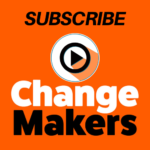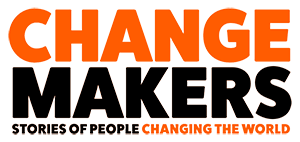What is the Green New Deal? It’s a process, not a policy.
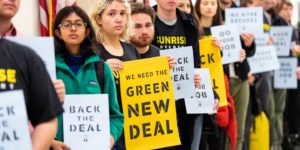
By Amanda Tattersall, ChangeMakers Host
In the US, Canada, UK and parts of Europe – a global movement of climate campaigners have begun turning to a so-called ‘Green New Deal’ as a way to speak about the economy wide transformation required to respond to climate change.
This idea speaks to a specific problem for economic and climate justice politics in Australia, where the disappointing 2019 Federal Election result could be partly interpreted as a gap between progressive climate and economic narratives.
The Green New Deal connects climate change – ‘Green’ – with the 1930’s economic transition in the US that delivered Keynesianism – the New Deal. In Australia, while the language of ‘Green New Deal’ would not be the right label for this platform, the idea clearly resonates, and several movements have begun to explore the concept.
But while the idea of a Green New Deal has great merit, its form will determine its effectiveness. For reasons gathered below, I argue that an Australian Green New Deal must be considered a process, not a policy. Do it wrong and it’s likely to fail. But do it right, and we can lead the world in how to do deep economic transition planning – while building a stronger, connected, democratic civil society at the same time.
Process not policy?
What does ‘process not policy’ mean? I mean that a Green New Deal is not a policy document that an ‘expert’ can squeeze out of their brain. We need a far more democratic form of expertise here, and while the science of climate change must inspire the seriousness of our response – it is the experiences, fears, interests and needs of affected communities (defined broadly – as climate change presents a broad disruption, it includes first nations people, mining communities, young people – and really is most of us) – that must be placed at the centre of how we build our transition. To do anything else is to be stymied by delay, the politics of reaction and opportunism.
So the process of a Green New Deal is about creating ways for those communities to place themselves at the centre of constructing the focus, priorities and plans for transition. And it isn’t about treating communities as separate – it is about connecting them. It is about creating spaces for powerful, engaged, listening and relating between logistics workers in outer Western Sydney and student strikers from the North Shore; or between church groups in Logan and nurses in Mackay. It’s about providing a space for people to share their anxieties and their hopes – in a constructive way. Instead of allowing opportunistic narrow-sighted political or corporate interests to fragment our ability to address our needs – it’s about casting the direction we need ourselves.
A process like this is excessively ambitious. It is all about identifying approaches, principles, values, timetables and milestones for long range work. There are so many questions that need to be answered by those who do the building. But we aren’t starting from scratch – we have so much history both here and overseas that we can draw from to guide us in what to do. From all of those practices, here is a set of lessons to consider as that work is done
Lesson One – it’s not a rush

The Green New Deal became a global sensation because of the combined efforts of the youth led Sunrise Movement in the US and newly elected Congresswoman Alexandria Ocasio-Cortez. With lightning speed and precision, through targeted occupations of Nancy Pelosi’s office and the development of a Congressional Resolution in February 2019, they put this concept on the map. And that’s remarkable because the idea isn’t new. It was first canvased in the UK in the wake of the Global Financial Crisis. It was an idea that lay dormant, waiting to emerge until the conditions became right.
In February and March 2019 the Green New Deal exploded onto the US political scene. It was the talk of the town in Washington. All the major US newspapers covered it, and the threat of climate change, in ways that had simply not occurred before. In only a few months an avant-garde movement had turned the tables on what was possible. It happened because the Green New Deal was an approach that sought to meet the scale of the challenge – it was not afraid to talk about zero emissions, eliminating flight travel, electric cars, and moving beyond coal.
Yet every action has a reaction, and the explosion of this new narrative met with stiff opposition fast. In particular, vast segments of the labour movement felt they hadn’t been consulted – and in return came out in strident opposition to the Green New Deal. This was most notable in the trades, where unions like the labourers said they would oppose any policy that ended even one job.
Social movements have always had to ‘do a dance’ around the dilemma of time. When do you go slow? When do you go fast? When do you push, when do you gather? When is a polarisation around an issue powerful and when does it polarise people against you? Social movements need a narrative that agitates for action – pushes people beyond their comfort zones, but one that doesn’t see (too many) people snap back and fight the agitation. Social movement’s don’t just dance in the now, they project time too, generating courageous big visions that imagine where we need to go as a people. This isn’t easy, and strong visions will face of opposition. But not all big visions, not all polarisations, are powerful. Social movements need to avoid the dance of empty righteousness – rhetoric that rejoices in the feelings of what should be without a concern for how we might get there and who might be affected by that journey. Social movements need to be a dance by the people – activiating people’s needs, hopes and bodies – not just a performance put on by self-appointed representatives of the people.
What’s the lesson here? That an Australian ‘Green New Deal’ doesn’t need to start from scratch. We can can learn from the US, UK and Canada. Some of these lessons are about doing things differently. We need to walk before we can run. The more interests and constituencies that can own it, have a stake in it – see their future wrapped up in it – the stronger it will be over time. We can learn how to dance together. Delaying a public release in order to build public ownership is an investment worth making. As a community organiser might say – it’s important to “build our power before we use our power.”
Lesson Two – coalitions aren’t simple things
The logic of lesson one is that you need a coalition – some way of holding a variety of interests, people, networks together. Great. But lesson two is that there is nothing easy about coalition building.
A familiar instinct when it comes to building a coalition is ‘let’s get everyone involved’ – “more is more.” People go around assembling everyone they can find into some grand coalition.
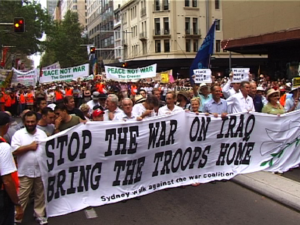
I know this because I’ve done it before. This is how we organised Sydney’s Walk against the War Coalition in 2002-03. We found as many groups as we could, over 90 at our peak. Big groups, little ones – and because we thought it would be democrat to to this, we gave everyone the same amount of voting power, and we processed to make decisions in very long, very large meetings. It was cumbersome – to say the least. We struggled to make decisions – so we settled on what I would call ‘lowest common denominator’ approaches: we did the things that would suit ‘everybody’ (so no one would get annoyed) and in doing so, we made very vanilla, unstrategic decisions that didn’t get us close to our purpose. In summary – we agreed to hold rallies – so we held big ones (including the largest rally in Australia’s history) and then smaller and smaller rallies until the trust broke between the group and we folded the coalition.
There is a risk that Green New Deal advocates will fall into the same trap.
So what do we do?
Remember the lesson, “less is more.” In Power in Coalition, documenting three five year studies of coalitions, I found that a small group of unusual coalition partners, who have the space to build trusting relationships across difference, who stand for the whole of the communities that you are seeking to organise – is forever more powerful than a coalition whose members are seen as very similar (like a coalition of unions, or a coalition of climate groups) or a coalition of organisations that don’t have many members (where the alliance is more like astroturf than grassroots).
Remember also the art of multi-scaled coalitions. A national coalition can only do so much. A national coalition is more like a jelly fish, hoping its tentacles will go deep, rather than an octopus that locates its brain in its numerous legs lying on the floor. Coalitions need to be active in lots of different places. And place matters when it comes to climate change – certain places will be more affected than others, they will experience greater fear and need to exercise more ownership around how any climate response is run. Places will be more powerful where local leaders, affected by climate change, are prepared to lead the fight, compared to places that don’t.
Even with these lessons – we don’t have many (any?) live examples to draw on to help us build what we need to build. We need to dare to imagine things that haven’t been done before. Even with frameworks like ‘less is more,’ there will still be a lot of groups with an interest in the Green New Deal – and we would do well to harvest their energy, create spaces for creative and targeted action, and generate a broad political movement (with a sharp political culture). So how do we do this? We can take ideas from Australia and beyond that can inspire, but do not need to constrain how we imagine how the project might unfold.
Some lessons can be sourced in community organising. The Sydney Alliance and Queensland Community Alliance have built long term coalitions across groups with a range of different interests (indeed across groups who have not traditionally got along) and they have held those spaces by developing a strong relational culture (where people learn how to know each other, and then how to talk honestly and frankly about their interests). Any Green New Deal coalition would be wise to borrow from this relational culture (reading list see below).
Another place to look are decentralised networks. Networks as diverse of the Your Rights at Work, Lock the Gate and Stop Adani in Australia, or Indivisible in the USA, all crafted decentralised networks where relatively autonomous local groups developed and enacted strong political strategy around the country. These groups were laterally connected, as well as connected to city, state and national strategy that was coordinated by more centralised groups (like union offices or NGOs). Figuring out how to actively engage everyday people alongside big organisations will be an essential ingredient for creating a people power movement that is able to create political momentum for the transitions required.
Another place is the digital creativity found in places like the Student Climate Strike and GetUp. While we need to recognise that tough decisions and planning for any multi-pronged social movement will be face to face, digital tools will be a necessary creative supplement for energising the movement. Usefully we have great strengths here, GetUp is one of the world’s most successful digital campaign organisations, and the student strikers – filled with digital natives – have transformed previously unused tools (like Instagram chats) and turned them to new organising spaces.
We can also think about other network models that we have used before. In 1996, the Climate Action Network Australia created (with a tongue in cheek irony) ‘coalitions of the willing’ as network hubs that ran discrete campaigns, based on a high degree of interest. Similarly, the Sydney Alliance’s multiple research-action teams were based on the idea that only certain groups would be interested in particular issues (so they needed to work on a series of issues to cater to a wider set of interests). In a different form, the snowflake model used by the Obama campaign could be useful for our coalition building work. This approach focuses on building small teams where each person plays a leadership role with discrete responsibilities (including running their own team). Snowflakes attach to other snowflakes as new leaders and pieces of work emerge. This could be translated to in the Green New Deal, as discrete planning teams are identified in sectors or places, that build a spidersweb to coordinate the approach.
Our multi-scaled work will also need to borrow concepts to work out how to make decisions. Because the big question is ‘who decides what’ when it comes to strategy and tactics? In the Alliance, we used the old catholic social justice principle of ‘subsidiarity’ to guide decision making. Subsidiarity is about allowing the most local body to make as many of the decisions as possible. This allows campaigns to be run with a place sensitive approach. But, subsidiarity also recognised that some decisions are interdependent, and require broader involvement. When a decision will impact others beyond the local, then people beyond the local must be involved.
Lesson Three – affected communities in the driving seat
The most counter-intuitive lesson about Green New Deal work is that it won’t work when its rushed. Because – shouldn’t it be a rush? Greta Thunberg calls on us all to panic! Government’s are declaring Climate Emergencies left right and centre (including most recently the City of Sydney). We should have shut down coal yesterday to stop 1.5 degrees. Right?
In organising we teach that every action has a reaction, and the reaction to panic is fear. The trouble with rushing the discussion about economic transition is that a predictable response is for communities, especially affected communities, to react negatively.
We saw this in the last election. We saw it on television in the response to the Stop Adani Convoy in Central Queensland, but it was also evident in the more quiet fear amongst mining unions that workers would vote (and did vote) for Pauline Hanson. Polarisation generates many reactions – sometimes it can polarise a majority towards you (like in Your Rights at Work), other times it can weaponise people against you.
One learning from all of this is that we should never be in a position where communities affected by climate change line up against climate action. Mining communities, like many others, are affected communities. Many people in those communities know full well that the mining companies are not on their side, and that organising and action is the only way to save themselves long term. But they also know that to date there is not a climate plan that they have ownership over about how they can save themselves. The Green New Deal offers us an opportunity to help those leaders to lead that plan, and in doing so shape the agenda for climate action. This has been a core part of the climate work in Germany. The work there has been tense, and social democrats and greens have wrestled over how mining communities lead change. But the fact that there has been a more holistic community response has meant that even a conservative government has led on ending coal dependency, building renewables faster than almost any other nation. In Australia we have people who have led this work too. Lock the Gate, Original Power and Amanda Cahil’s new economy work have each sought to generate ownership and planning processes for fossil fuel affected communities.
Beyond the immediate lessons, we know there is deep learning for white Australia from our first nations people around how to care for this country. We need to learn to listen more as we build an approach to transition how our economy, and community, works together.
Lesson Four – Learn from each other
While many social movements use similar terms – like organiser or leader – scratch the surface and you will see incredible differences. What Amnesty, the union United Voice, 350.org, GetUp and Sydney Alliance call an ‘organiser’ is utterly and completely different. These differences are driven by different beliefs about how change is won and different understandings about the kind of democratic movement we are building in the process.
Based on our discrete experience, many of us have pretty strong opinions about what forms of ‘organising’ we think is ‘better’ than others. But what is perplexing is that we spend very little time in reflective conversation between us, learning from the strengths of our different approaches.
Organising scholarship doesn’t help us much either. Most writers tend to bracket certain organising practices in an argument that says ‘this works, this doesn’t.’ As remarkable as their work is – Jane McAlevey, Becky Bond and Hahrie Han make an argument for a certain kind of organising practice. McAlevey argues for a dedicated organising practice and Becky argues for a creative mobilising practice. While Han also recognises that mobilising has a place (which, in practice, in Australia, is actually what a vast majority of ‘organisers’ do), she also argues that organising is superior. But is it? Are we actually in dialogue about this as ‘organisers’? If it is superior, then why are we doing so much mobilising? If it isn’t, how can we shake up organising practice so it is more nuanced? Or, is it actually the case that there are multiple strategies that need to be deployed in nuanced ways that we miss – because we have an opinion that one practice is better than another? We don’t have an active dialogue about those multiple strategies – while Bond talks about electoral organising, McAlevey and Han do not.
On top of this, there is a habit in Australia – maybe it’s our cultural cringe – to hear an approach tested overseas and apply it. I know that I’m guilty of this. Two organisations that I helped found – GetUp and Sydney Alliance were Australian adaptations of US examples. But is this working for us? Of course we must be learning from our allies around the world, but we can’t just be cookie cutting other people’s approaches. How are we building a learning and adaptive practice in Australia so we build approaches slowly – iteratively – through our own reflection and lessons as well as overseas inspiration.
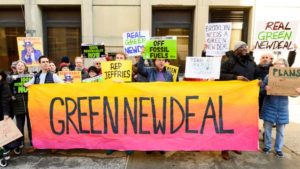 The Green New Deal must be underpinned by a rigorous Australian interpretation – we have to adapt our economy, not someone else’s. We discussed how the actual content of the Deal must embody this, but so must the organising approach that is used to build it. This invites us all to embrace a rich learning and evaluation culture for our organising work as we build the Green New Deal.
The Green New Deal must be underpinned by a rigorous Australian interpretation – we have to adapt our economy, not someone else’s. We discussed how the actual content of the Deal must embody this, but so must the organising approach that is used to build it. This invites us all to embrace a rich learning and evaluation culture for our organising work as we build the Green New Deal.
What would a rich learning culture look like? All meetings and processes would be debriefed, lessons learned and practice changed. That is, after all, where leaders develop – by reflecting on what they did and how they could do it better. But beyond this, imagine if the Green New Deal was also about sparking a rich learning culture across our movements. Imagine if we created spaces – like movement ‘think tanks’ where we consistently held reflection discussions (learning clubs). Imagine if we ran a program of ad hoc exchanges, where union organisers spent time with the Stop Adani campaign, or GetUp organisers spent time with the Pacific Warriors. Organising is practiced in diverse communities differently. White organisers have so much to learn from our first nations and people of colour allies, and this is a moment where we could be intentional about that exchange. Imagine if we created a culture between our organisations that was truly honest – where we didn’t just sing a song about how great everything worked, where we didn’t get defensive about our mistakes, but where we created spaces where we could exchange and change based on what did and didn’t work well. We can only imagine.
Lesson Five – It can be a process
We can build a Green New Deal as we go. If we are going to build something that dramatically and differently changes Australian politics, then it requires us to do things that are dramatic and different. The biggest priorities will be forging new relationships, genuinely understanding the needs of our new partners, and through that creating a new plan together. To do it, we will all need to surrender a little control in order to build more power together.
Not every organisation will be up for this. But if enough people – from big organisations and smaller networks – committed to creating a plan that transforms our economy to respond our changing climate – that’s what will make the Green New Deal process work.
Timelines, networks, groupings will form. Like any organising project – the network will hold in tension the world as it should be and the world as it is, pushing from today into what we can create together. We will need to be adaptive – on our toes – because changing political landscapes require flexibility and dynamism.
We will need to surf the wave. We can prepare for it, some of us have been to similar beaches and can help teach others to surf – but not all of this can be planned.
A focus will be planning – identifying what needs to change, what could be the consequences of that plan to create a transition that cares for people and supports a fair economy in the process. Some projects will be local, some will reside in our national parliament. Other projects will be with corporations, some will confront corporate climate changers, and others again will be solutions created by us ourselves.
And most importantly the whole process will be one grounded in politics and power. We will teach that while behavioural changes like recycling are fine, we will only successfully stop climate change if we transform the carbon centres of our economy – energy, agriculture, transport and how our cities run. But, while personal choices might have a limited impact – every single one of us – as political people – has immense power to make political change. Creating spaces for meaningful leadership will be our challenge and the measure of our work.
In doing so, a Green New Deal can revive our democracy. Not only in Australia, but across much of the world, our democractic institutions and systems are struggling. People hate politicians and distrust politics, and in this environment populism is rife. In the past, democratic advocates relied on the vote as the means for winning change – the refrain was ‘just vote people out if you want a different future.’ We know that isn’t nearly enough to solve climate change.
We need an engaged politics in this country – where people can claim a sense of ownership over their lives, their towns and their future. If people want change, they can’t just vote for it – they need to get in the arena and be part of making the future they need for their community, their kids, their world.
We need an approach to political life that allows people to scale their ambitions – to achieve change locally – and in their city or region – and in their country – and on their planet. The Green New Deal offers us all a chance to create this kind of change. Climate change requires political solutions that meet the scale of the problem. A Green New Deal that is capable of multi-layered community leadership and deeply networked community interests might offer us the process that can meet the greatest challenge that we have ever faced as a species.
Reading List
Coalition Building
Power in Coalition, by Amanda Tattersall
How to Win, ChangeMakers episode #2
Community Organising
Roots for Radicals by Ed Chambers
Going Public, by Mike Gecan
Faithful Citizen, by Austin Iverleigh
A bunch of shorter articles on the Resources section of ChangeMakers website
Networks
Worth Fighting For, by Kathy Muir
Indivisible campaign, ChangeMaker Podcast Episode 13 (series 2)
Join our weekly email list to hear our latest musings, podcasts and training. Click on this button to subscribe:
